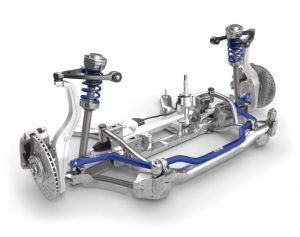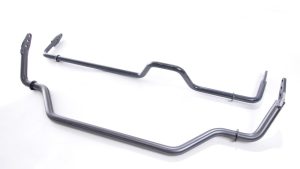Suspension systems are among the most complex and important aspects of vehicle design. At the heart of these systems lies a critical, often underestimated component: the stabilizer bar (also called anti-roll bar or sway bar). While the bar itself plays a major role in resisting body roll, its performance is deeply influenced by suspension geometry — the angles and positioning of suspension components.
In this article, we’ll explore how suspension geometry affects stabilizer bar function, how different setups alter handling characteristics, and what you should consider when upgrading or replacing stabilizer bars.
What Is Suspension Geometry?
Suspension geometry refers to the three-dimensional layout of a vehicle’s suspension system — specifically the alignment angles and relationships between components like control arms, shocks, springs, and the stabilizer bar.
Key Geometry Elements:
-
Camber – Angle of the wheels relative to vertical
-
Caster – Steering axis tilt from vertical
-
Toe – Angle of wheels pointing inward/outward
-
Roll center – Pivot point around which the vehicle rolls
-
Track width – Distance between wheels on the same axle
-
Control arm angle – Affects leverage and articulation
-
Anti-roll bar link angle – Impacts load transfer efficiency
Each of these angles and positions affects how the stabilizer bar reacts to suspension travel, especially during cornering or over uneven roads.
Stabilizer Bar: Function Refresher

The stabilizer bar connects the left and right wheels through the suspension arms. When one wheel moves up (as in a corner), the bar twists, transferring some of that force to the opposite side, thereby resisting roll.
Components:
-
Bar itself (usually steel)
-
End links – connect the bar to the suspension arms
-
Bushings – secure the bar to the chassis, allowing rotation
The effectiveness of this setup relies not only on the stiffness of the bar but also on the geometry of the suspension arms and links.
How Suspension Geometry Impacts Stabilizer Bar Behavior
| Geometry Factor | Effect on Stabilizer Bar Performance |
|---|---|
| Control arm length/angle | Alters lever arm and effectiveness of bar movement |
| Ride height | Changes end link angles, reducing bar efficiency if not adjusted |
| Camber change | Affects contact patch during roll, influencing bar resistance |
| Roll center height | A lower roll center increases body roll, putting more load on bar |
| Suspension travel range | Larger travel may bind or overstress bar if geometry is off |
1. Control Arm Position & Length
The position and length of lower and upper control arms determine the arc in which the suspension moves. If the end links of the stabilizer bar attach too close or too far from the pivot points, it changes the leverage ratio — meaning the bar either becomes too stiff (less articulation) or too soft (less effective roll resistance).
Tip: Always check stabilizer bar link position relative to control arm angle.
2. Ride Height & Suspension Lift/Drop
Changing the ride height (lowering or lifting a vehicle) alters suspension angles and end link geometry. If the stabilizer bar links are now pointing too far up or down at rest, the bar may:
-
Engage too early (leading to harshness)
-
Not engage enough (leading to body roll)
-
Bind during travel (causing noise or failure)
Solution: Use adjustable end links when ride height is modified.
3. Camber and Toe Changes
Although stabilizer bars don’t directly influence camber or toe, changes in these angles affect how the suspension reacts during turns. If camber gain (camber change during compression) is too aggressive, the stabilizer bar might not be enough to prevent tire lift, reducing cornering grip.
4. Roll Center Height
The roll center is a theoretical point around which the car rolls during lateral motion.
-
High roll center: Less body roll, stabilizer bar less active
-
Low roll center: More body roll, stabilizer bar works harder
Performance tuning often involves adjusting suspension geometry and bar stiffness together to balance roll behavior without compromising comfort.
Common Suspension Types and Their Effect on Stabilizer Bars
| Suspension Type | Stabilizer Geometry Challenge | Effect on Handling |
|---|---|---|
| MacPherson Strut | Limited space, requires vertical links | Simple, but less adjustable |
| Double Wishbone | Allows more accurate link placement | Highly tunable, more efficient stabilizer behavior |
| Multi-link Rear Suspension | Varying angles make setup complex | Demands precision in link length and angle |
| Solid Axle (Trucks) | Less independent movement, bar works differently | Limited body roll control |
Stabilizer Bar Tuning & Geometry Optimization
| Parameter | Effect |
|---|---|
| Bar thickness | Thicker = stiffer response, less roll |
| End link angle | Should be near vertical for optimal load transfer |
| Bushing type | Polyurethane = stiffer, more responsive |
| Bar material | Hollow = lighter but still stiff; solid = stronger but heavier |
| Mount location | Further from pivot = more leverage, more body control |
Important: When changing bar thickness or lowering your vehicle, review link geometry to avoid preload or misalignment.
Best Practices for Performance and Safety
-
Aftermarket suspension upgrades? Use adjustable links.
-
Lowered vehicle? Recalculate bar angles.
-
Off-road or lifted vehicle? Use flexible, longer bars.
-
Hearing clunks or squeaks? Check bushing wear or link angles.
-
Mixing components? Always verify geometry compatibility.
Where to Buy Stabilizer Bars and Components

Need stabilizer bars, links, or bushings tailored to your suspension geometry?
Buy Stabilizer & Components online
This online shop offers a wide selection of stabilizer systems and parts for all vehicle types, from daily drivers to performance cars and SUVs. Use their compatibility filter to find exact-fit components for your specific suspension setup.
Final Thoughts
Stabilizer bars may seem simple at first glance, but their performance is closely tied to the suspension geometry of your vehicle. Even the best sway bar can underperform if the end links are misaligned, control arms are poorly positioned, or ride height isn’t compensated for.
Understanding how geometry influences sway bar function ensures that:
-
Handling remains sharp and balanced
-
Components don’t wear out prematurely
-
Your vehicle reacts predictably under all driving conditions
Whether you’re upgrading for performance or simply replacing worn components, don’t overlook the role of suspension geometry.
Ready to improve your handling?
Buy Stabilizer & Components online and get the parts that work in harmony with your suspension layout.